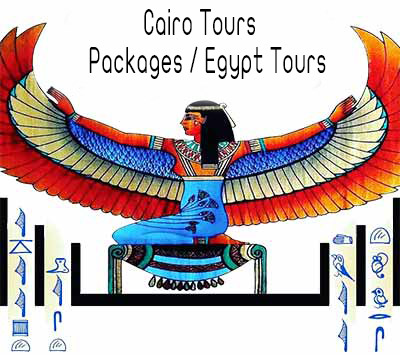Visitors to Luxor should try to visit the famous Temple of Hathor at Dendera if they have the chance. By taxi, the trip takes about 1 hour, from Luxor. The buses, which are always accompanied by a police convoy, leave at8 AM daily. The entrance fee is LE 35.
The Temple is about 4km from the west bank of the Nile roughly opposite the city of Qena. The capital of the province and governorate of Qena (population - 2,000,000), is inhabited by both Coptic and Muslims. This town is famous for the manufacturing of water pots, called "gula" jars in Arabic.
The Muslim Sheik, Abdel Raheem El-Kenawi, spent all of his life in this town. His death, in 1170 A.D, founded the modern city, and his birthday is celebrated every year. A great number of pilgrims come from all over Egypt for the festivities. Qena's name dates back to the time of the pharaohs, and was taken from the ancient Egyptian word Qeny, which means, "to bend"; the River Nile has a huge (and famous) bend here.
The Temple of Hathor was built in the 1st century B.C by Ptolemy VIII and Queen Cleopatra II, and it's is one of the best-preserved Temples in all of Egypt! Later, Roman Emperors continued to decorate it to honor the Hathor, the goddess of maternity, love, and music. The Greeks knew Hathor as Aphrodite.
The first gateway, built by Roman Emperor Domitian in 80 A.D, leads to the well-preserved great hall, which is decorated with Hathoric columns (columns with the face of Hathor on them). The upper, front edge of the cornice is decorated with the winged sun disc, while stone screens between the columns and the scene representing the Roman Emperor Tiberius and other Roman rulers who present votive offerings to the Goddess of the Temple, enclose the front portion. Hathor is mainly represented, with the horns of the sacred cow protruding from her head, supporting the solar disc of the sun. In her hands she holds an "Ankh" (the symbol of life), and a scepter.
The interior walls of the great hall have remarkable scenes depicting sacrifices made to the goddess of the temple. The amazing ceiling abounds with astronomical representations!
The ceiling is divided into 7 ways, and the best remaining 3 are:
1. The first division on the eastern side, which depicts the Nut, the goddess of the Sky, who is bending herself towards the earth, with the sun disc shining on the temple and the mask of Hathor.
2. secondly, and next to the first, is a representation of the sun boat and star goddess.
3. The third one is the western ceiling, which shows a perfect representation of the zodiac signs, one of the reasons that the temple is so beloved (the original zodiac relief is now in the Louvre museum in Paris, France). The 12 figures are the ram, the bull, the heavenly twins, the crab, the lion, the virgin, the scales, the scorpion, the archer, the goat, the watering pots and fishes with glittering tails. On the inner walls of the screen, the hawk-headed god Horus, and the Ibis-headed god Thoth, are pouring drops of holy water over the king. This scene is called the baptism scene, symbolizing life and happiness.
The second hall has 6 columns adorned with rich capitals and granite pedestals. On both sides of this hall are small storerooms, used to store the wine jars that came from the Island of Crete, and the fertile Fayoum and Kharga oases.
Next is the central chapel and its two altars; one for the sacred boat and the other for the sacrifices offered to the Goddess Hathor. The beautifully sculptured reliefs on the walls of the shrines represent Ptolemy VIII and other rulers, whose names were left blank in the oval cartouches, dancing with offerings to the sacred boat of Hathor and her husband Horus. The representatives of the king, the high priests, and some noblemen, once gathered in the great hall to prepare for the daily rituals. The ceilings are covered in stars and black soot from the fires caused by later inhabitants of the Temple. The rooms around the sanctuary were used for scientific purposes, as well as the storing of the sacred boat, the sacred wreath, the golden image of the Goddess Hathor and musical instruments.
There is a small corridor on the right, which leads to a small room that contains the crypt, a great spot to visit. The staircases, which lead to the roof of the temple, are decorated with beautiful symbols of the 12 months of the year. On the eastern corner, of the roof, is the chapel of the god Osiris. The scenes on its walls represent Osiris rising from the dead and becoming the god of the underworld. It is from this chapel that the best representation of the zodiac was taken.


